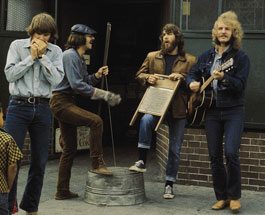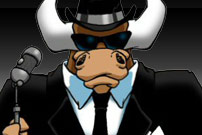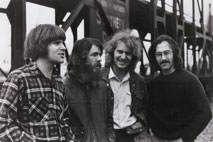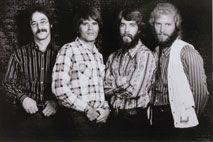 With the temperature dropping, it's time to find someone to keep you warm. Find your hookups with our online dating guide!
With the temperature dropping, it's time to find someone to keep you warm. Find your hookups with our online dating guide!

Creedence Clearwater Revival
Celebrities Home / Entertainment Home
Thanks in large part to the post-modern self-consciousness of American popular culture (cf. “Forrest Gump” and beyond), the music of Creedence Clearwater Revival continues to resonate with contemporary audiences. When a movie or TV show needs to convey the time period of say, Vietnam, “Fortunate Son” is inevitably a favorite on the list. “Run Through the Jungle,” “Bad Moon Rising” and “Have You Ever Seen the Rain?” follow close behind.
But it would be unfair to box CCR into being a product of 1960s turmoil that lost its relevance when Saigon fell. Tom and John Fogerty, Berkeley born and bred, and Stu Cook and Doug Clifford from neighboring El Cerrito signed with San Francisco-based Fantasy Records in 1964. Stu, Doug, and John had formed The Blue Velvets while seniors in high school – first backing Tom and then incorporating him into their own band. Upon signing with Fantasy, their name changed to The Golliwogs, with Tom Fogerty spearheading most of the singing.
John Fogerty and Doug Clifford were drafted in 1966, both serving in the reserve units of the Army and Coast Guard, respectively. This temporary separation from their routine would serve as a catalyst for the changes that would occur – and prove to have far-reaching effects for the band’s success – down the road. Upon completion of active duty, Doug returned to the drums, Stu was at bass, with Tom now at rhythm guitar, and John assuming lead vocals and principal song writing duties. A major victory at the time, but who would ultimately prove to be a fierce enemy, was the introduction of The Golliwogs to Saul Zaentz in 1967. It was under Zaentz that the band changed names yet again, settling on Creedence Clearwater Revival.
Creedence Clearwater Revival introduced the world to the group with its debut in the summer of 1968. Considered a “testing of the waters,” the tracks reveal a band still finding its way and its singer still finding his voice. A mesh between what was happening around them, musically (particularly with the quasi-psychedelic “Susie Q,” even though the band would not be known to associate with the nearby Haight-Ashbury scene) and their own interests – the bluesy “I Put a Spell on You” and the swamp sound of “The Working Man.” The discipline and productivity that would spawn the incredible trajectory of the next two years would yield a second album just a few months later.
Bayou Country followed in January 1969 with seven tracks to its name. It is now generally regarded as the first true CCR album, especially with “Born on the Bayou” kicking off the record. With “Proud Mary,” CCR developed a strong and far-reaching kinship with the swamp sound – that funky, twangy, Southern Gothic feel to the music. It was as if John Fogerty was from rural New Orleans, in tune with the myths of the American South folklore, and that he owed more to Robert Johnson than Berkeley. Indeed, it would be the Delta in which Fogerty would find himself years later at the end of his spiritual and creative rope, longing for a revival greater perhaps than the name that bore his legacy.
With Green River released only seven months later in August 1969 and featuring “Bad Moon Rising” and “Lodi,” CCR and Fogerty’s writing was at the peak of its powers. The somewhat pessimistic lyrics are masked by the general upbeat tone of CCR’s music. And by November, Willy and the Poor Boys was on shelves with singles like “Fortunate Son” and “Down on the Corner” topping the charts. Did CCR recognize its incredible output in 1969, its tunes speaking for a misplaced generation fighting a misguided war? It was the production that really spoke – three albums and four hit singles, with Dylan citing “Proud Mary” as his favorite song of the year. In typical irony, the group followed the Grateful Dead at three in the morning at Woodstock and was left out of the concert movie edited by Scorsese the following year. In response, the double-sided 45 “Travelin’ Band” / “Who’ll Stop the Rain” was released just after the turn of the year. In February 1970, they were on the cover of Rolling Stone, and with the disbanding of the Beatles, CCR stood alone.
“Travelin’ Band” and “Who’ll Stop the Rain” both appeared on the July 1970 record Cosmo’s Factory that featured a vast majority of the songs that continue to get air time today: “Lookin’ Out My Back Door,” “Run Through the Jungle,” “Up Around the Bend,” the cover “I Heard It Through the Grapevine,” and “Long As I Can See the Light.” But the seeds of discord were being planted as Fogerty sought tighter creative control and shunning input from the other three members. Pendulum, the December 1970 record, was mostly a response to critics dismissing the group as a “bubblegum pop band.” It is in no way a retread of anything previous – each record seemed an extension of the prior work – and with songs particularly like “Rude Awakening #2,” CCR forayed into less certain ground. What might have resulted if they had remained as prolific into 1971 as they had been the previous years is an interesting thought to entertain, but it didn’t matter. Tom Fogerty left in February, a year after the appearance on Rolling Stone, and a year after John was the only band member to give an interview to the magazine.
John continued working with Stu and Doug, although tensions were more than strained. Mardi Gras was the last Creedence Clearwater Revival album released in April 1972. They disbanded on October 16 of that year. But the legal problems were only beginning, primarily revolving around questionable business moves John made with Fantasy. Still only in their 20s, all embarked on solo careers, with John the most successful. Stu and Doug would later form Creedence Clearwater Revisited in the 1990s. As for Creedence Clearwater Revival, they may not have simply been a crash and burn band, they did not necessarily define a pivotal and tumultuous time in America, either. They were themselves, and they had something to say. The resonances of such powerful music continues to be felt today, and while pop culture packages their hit songs into its own products, CCR deserves a serious study of its output. Their impact is not to be taken lightly.
Creedence Clearwater Revival Gallery
|
 Tired of striking out? Check out these Dating Tips for all sorts of advice on how to finally get the girl! Also, we tell you all about some of the best online dating sites and how you can use them to hook up with more women!
Tired of striking out? Check out these Dating Tips for all sorts of advice on how to finally get the girl! Also, we tell you all about some of the best online dating sites and how you can use them to hook up with more women!
CCR on the Web
IMDb
Comprehensive list of films featuring CCR on the soundtrack.
Wikipedia
In-depth entry charting the rise and fall of the band.
Official YouTube Page
CCR’s page with short video clips and concert footage.
CCR on the Radio
CCR, in addition to their tremendous records, are one of the most successful singles band in rock history. With singles like “I Put a Spell on You,” “Proud Mary,” Bad Moon Rising,” “Fortunate Son,” “Someday Never Comes,” and “I Heard It Through the Grapevine,” it’s no wonder they were inducted into the Hall of Fame in 1993.
CCR Says
Tom on lead singing duties:
“I could sing, but John had a sound.”
John on “Fortunate Son”:
“Richard Nixon is a great inspiration.”
You can follow us on Twitter and Facebook for content updates. Also, sign up for our email list for weekly updates and check us out on Google+ as well.












